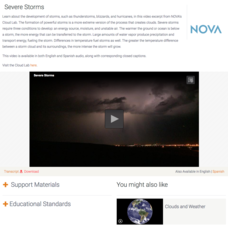Howard Hughes Medical Institute
AZT Blocks Reverse Transcriptase
AZT, developed in the 1960s to treat cancer, actually treats HIV as well. Viewers observe how AZT blocks the reverse transcriptase of HIV. Then they see what happens when the virus mutates to be immune to AZT.
Howard Hughes Medical Institute
Human Embryonic Development
At what point in the fertilization process do stem cells turn into an embryo? Viewers observe the development of an embryo from egg to fertilization to development into a fetus. The narrator stresses the role of cell division,...
Howard Hughes Medical Institute
Cytoplasmic Factors
Cell division, cell expansion, and cell growth all take place in the cytoplasm exclusively. Young biologists learn about the role of cytoplasmic factors in cell development through and animated video.
PBS
Clouds and Weather
The sun heats Earth's surface unevenly, causing crazy weather patterns around the globe. A NOVA video describes the resulting changes in air pressure, temperature, humidity and their impacts on weather. It connects the concepts to...
PBS
Severe Storms
Approximately 2,000 thunderstorms happen simultaneously across the planet at any given time—that's a lot! Beginning with how clouds form, NOVA describes the conditions needed for storms to develop, and highlights the three factors that...
Howard Hughes Medical Institute
Newt Limb Regeneration
Some amphibians respond to amputated limbs by fully regenerating functioning limbs. A short video permits viewers to observe a newt's cells working as stem cells, differentiating and regenerating into bones, muscle, skin, nerves, blood...
Howard Hughes Medical Institute
Differentiation and the Fate of Cells
Did you realize cells become restricted in the types of cells they produce as embryos develop? Stem cells might become anything, but late state cells can only become the specialized cell based on their locations. A captivating video does...
PBS
The Climate Wild Card
If Earth didn't have clouds, the global temperature would be at least 22 degrees Fahrenheit warmer. Viewers examine the importance of clouds on temperature, climate, and global warming. The video describes the current impact of clouds...
PBS
Why So Many Cloud Types?
Scientists categorize clouds by both height and shape since both traits impact the weather independently. Viewers fly high to learn about the characteristics of each type of cloud. NOVA explains the composition of clouds, the atmospheric...
PBS
The Coriolis Effect Due to Earth's Rotation
Why do big storms spin as they travel? As Earth spins, the movement of air and water change. Viewers observe the Coriolis effect on paper airplanes, water, and even hurricanes—and find the effect is everywhere!
Howard Hughes Medical Institute
Somatic Cell Nuclear Transfer Animation
One cloning technique is somatic cell nuclear transfer (SCNT). Observe the process in action through an animated video. Review the applications of the process for both therapeutic cloning and cloning of an individual.
PBS
Biogeography: Where Life Lives
Biogeography is the study of the geographical distribution of plants and animals. NOVA's Evolution Lab explains how organisms on different continents can be so closely related. The resource discusses the processes that bring life from...
PBS
Evolution 101
Have you been shaped by evolution? A short video introduces the idea of evolution through examples of natural selection, reproduction, traits, and more. The video exists as a small part of a series from the NOVA Evolution Lab.
Howard Hughes Medical Institute
The Geologic Carbon Cycle
What happens to the CO2 emitted into the air by volcanoes? Scientists discovered it is removed through a series of chemical reactions, as discussed here. Through an animated diagram and chemical reaction equations, viewers learn about...
Howard Hughes Medical Institute
Greenhouse Effect
Without the greenhouse effect, Earth's temperature would be approximately 30 degrees Celsius colder. Scientists know this to be the case based on the study of other planets and the way gases absorb radiation. Viewers connect the ideas...
PBS
DNA Spells Evolution
In humans, the rate of mutation from one generation to the next is between 100 and 200 mutations. Discover the role of DNA mutation in evolution with an enriching lab activity.
PBS
Fossils: Rocking the Earth
Scientists learn about animals and plants living today by understanding the fossil record. A helpful resource includes a brief explanation of the process to help scholars complete the online game. It also mentions the gaps in knowledge...
PBS
Training Trees
Each branch of a phylogenetic represents a species, and you can trace each one back through history. A short video, the fourth of seven, introduces phylogenetic trees and the online game lab used in the unit.
Periodic Videos
Tennessine
Some isotopes of tennessine decay through spontaneous fission. When only one atom can be produced at a time, many people are surprised with what we know and don't know about this element. Individuals learn what we do know in the...
Periodic Videos
The Smelliest Element: Livermorium
The most stable isotope of livermorium has a half-life of around 53 milliseconds. Pupils understand the synthetic element and appreciate the unique properties with a video on livermorium. It describes the many scientists who collaborated...
Periodic Videos
Flerovium
The atomic weight of flerovium is considered provisional until more research is performed on it. Viewers learn about the discovery, confirmation, research, and naming of the synthetic element with an engaging and informative video.
Periodic Videos
Copernicium
Copernicium's symbol is Cn rather than Cp because Cp was once the symbol for lutetium and that might get confusing. Pupils learn about one of the newest elements on the periodic table with a video that focuses on copernicium.
Periodic Videos
Darmstadtium
Scientists originally discovered darmstadtium in 1994 in Germany. A chemistry professor shows the lab where this happened and describes the process of creating the synthetic element in an engaging video.
Periodic Videos
Hassium
Hassium decays so quickly that scientists do not expect to ever see the element in an observable state. Chemists share more about the synthetic element by visiting the lab in which researchers discovered it. They explain the properties...























